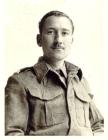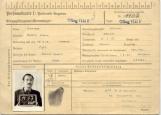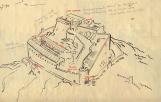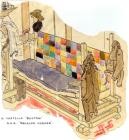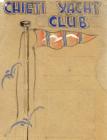2
Ronald Edwin Buxton was born August 1914 and grew up in post WW1 England.In the summer of 1939 it was becoming very obvious that Britain was on the brink of war with Germany, a fact confirmed by PM Chamberlain on that fateful Sunday morning in September.
Many of Buxton's friends were already in the Territorial Army and were being quickly mustered into the Regular Army.
Buxton however, like so many young men at that time, wanted to fly and wrote to the Air Ministry offering his services.
No answer was forthcoming and feeling that he could no longer wait he enlisted in the Army and was posted to "B" Battery, the Honorable Artillery Company in late 1939.
There appeared to be little happening in this "cold war" period so when a call came for volunteers for Special Service Units being assembled at the request of PM Churchill.
Buxton along with many others volunteered.
3
Pencil Sketch of Lieutenant Ronald Edwin Buxton, Royal Tank Regiment1943
Sketch Completed in Prisoner of War Camp
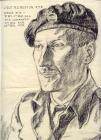
4
Those who were selected found they had become founder members of #4 Commando whose role would be "hit and run" raids on the enemy coastline.5
The Unit mustered in Weymouth and although it only stayed there for only a short time, it gave a few members an opportunity to "wet their feet". About six were chosen to provide additional fire power on two trawlers which had been fitted with degaussing gear to neutralize magnetic mines. Unfortunately nothing materialized and the expedition was concluded. It was during this expedition that Buxton resolved never to be a sailor!The Unit was quickly fully mustered and sent to Scotland where they found their home for the next several months to be the old ship "Glengyle", moored in Loch Fyne at Inverary. After several months of very strenuous training, including night exercises and extremely tough and long marches through the hills, Buxton was recommended for a Commission and was sent to Sandhurst where he graduated from the Armoured Corps Wing as a Second Lieutenant in early 1941.
Buxton was then posted to 9th Battalion Royal Tank Regiment then stationed at Otley in Yorkshire from where, shortly, after arrival, the Battalion was supplied with the first "Churchill Tanks" and then was relocated to the south coast at Eastbourne.
From here Buxton received his "marching orders" and in 1941 was posted to the Middle East, a journey which took many weeks as the Mediteranean Sea was a hotbed of trouble with all parties attempting to sink anything in sight. The Battalion was forced to make a detour almost to the Azores and moored eventually in the harbour in Freetown, Sierra Leone.
The troops then left Sierra Leone in convoy and moored for two days in Cape Town harbour before proceeding through the Straights of Madagascar up through The Red Sea to Port Tewfiq.
Buxton spent about two months at Abbasia barracks in Cairo before being posted to 44th Battalion Royal Tank Regiment which was, at that time, located in Box 150 on the east side of the Gazala line which terminated at Bir Hacheim, then occupied by the Free French forces. These "Boxes" were positioned strategically behind the Gazala line to provide immediate response should the line be breached.
However Rommel, realized the difficulties of attempting to breach the line at the Mediterranean end and making a successful frontal attack, decided to take his troops south to Bir Hacheim, where they liquidated the Free French forces who fought very well but were outnumbered and outclassed. It was a day in late May 1942 when it was realized that Rommel not only had quickly dealt with the Free French forces but had also managed to get between the Allied Troops and Cairo.
So the battle began. Later, the fiercest battles were fought in two areas known as the "Cauldron" and "Knightsbridge".
The Allied forces were hopelessly outgunned by the Germans who brought in their 88mm guns which decimated an entire Battalion of our tanks (we lost over 50 tanks) in a few days. The only opposition the Allied tanks could provide was from the "two pounder" which could, with luck at 500 yards, knock the paint off the German tanks.
In actual fact, it was being outgunned which resulted in Buxton subsequently being captured in the desert in Libya.
Buxton had to bail out of two tanks. The first time, his tank was hit by an armour piercing shell which, after damaging the engine and causing a lot of smoke inside the turret, ricocheted around inside the tank and struck the gunner. Buxton had to extract himself and his badly wounded gunner. It was later discovered that the gunner had the unexploded armour piercing shell imbedded in his thigh.
The second bail out was unfortunately into the arms of a German Infantry Platoon.
Buxton then became, along with a number of other British troops, a "KREIGENFANGER".
7
Ronald Edwin BuxtonPrisoner of War Camp Identification - 1943
8
Buxton was detained in the Bir Hacheim area by the Germans where he saw Rommell himself. Buxton wondered if he is the most "senior" Veteran that saw Rommell alive.The Germans then passed Buxton on to the Italians in Derna (Libya) and he was eventually taken to Taranto (possibly the largest seaport) located on the southern heel of Italy. The POWs were transported in the belly of an old Italian freighter and were battened down for the four day journey.
On arrival the POWs loudly cheered the sight of the remainder of the Italian fleet which had recently been severely bombed and would appear to have been put out of action for possibly the rest of the war.
The Italians did not like this reaction so when we had disembarked our heads were closely shaved.
This was just as well as when we got to Tuturano (between Brindesi and Taranto) the huts were so full of fleas and bedbugs there was barely room for any of the POWs.
From Tutarano we were moved by the Italians north to Gavi, a six hundred year old castle, from which the Italians boastingly stated that no POW would ever escape. This "myth" was shattered a short time later by three determined and ingenious POWs, much to the embarrassment of the Italians.
10
POW CampGavi, Italy
Buxton arrived in Gavi in July 1943.
A few months later, Buxton was transported to Chieti, located on the east coast of Italy. Here Buxton (along with about forty other POWs) contracted hepatitis. They all recovered in spite of the fact that the Germans had taken all the medicine so there was nothing to treat the prisoners with.
Accommodation was sparse - eight men to a very small room.
12
Buxton spent the summer of 1943 in Chieti. This was his area......Castello Buxtoni a.k.a.
Squalor Corner
An important part of the prisoner's job was to attempt to escape and to that end they came up with some very ingenious ways to cover up their activities. They had to assemble undetected so formed clubs in order to hatch their plans.
14
Chieti Yacht ClubAngling Club
